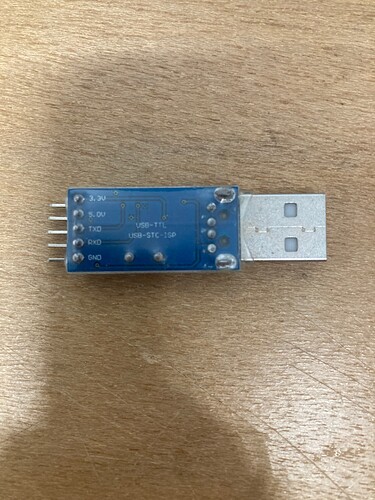Can you please post the pinout for the PL2303HXA TTL-USB adapter (USB to TTL UART RS232 Serial Converter Module PL2303HXA | Buy in Australia | CE05185 | Core Electronics)
Hi there, @Degan297978, and welcome to the forum. Glad to have you here.
I’ll get a better picture uploaded onto the webpage, but for now:
From top to bottom:
- 3.3V
- 5V
- TXD
- RXD
- GND
That’s great. Thank you
Hi Jane
Oops, too many Gnd in your list. I think the one next to “TXD” should be “RXD”.
Typo I am sure.
I am not going to use one of these devices but getting to the age old question of which way the signal is going, OUT of the TX and IN the RX. As this is essentially an extension or adaption of a USB cable I would assume the data comes OUT of the TX pin and connects to the RX (IN) point of the TTL device.
At this level it is not a big deal I suppose, if it doesn’t work swap a couple of connections and try again. But one large project I had to sort out years ago had several sites. Two of the main sites had something like 600 audio circuits out of the site. 39 X 16 channel intercoms plus radio traffic of up to 45 operators. All part of a voice switch system with priorities etc. Each circuit could go via several process on the way. Each process would be designed by an individual team BUT each had their own idea of TX and RX. Mostly referring to the direction of the circuit WRT their own process and circuit boards.
As you can imagine this was developing into a real mess and impossible for me who had to sort out all the wiring, Audio, PTT, Codan etc. After a lot of table thumping and discussion a protocol was sorted. Anything going away FROM the operator or out of the site is to be referred to as TX and anything coming toward IN to the operator is RX. This was given the stamp of approval by the customer. Everybody was at last on the same page and all lived happily ever after.
All good fun
Cheers Bob
Whoops, thanks Bob, I definitely should have had a second coffee yesterday.
That sounds like one heck of a headache there, Bob.
As far as I’m aware the the TX is the Data OUT here and the RX the Data IN.
This product is a naked version of this product which is designed mostly for use with a single circuit. I can easily see this becoming a nightmare with a larger number if circuits, however.
Hi Jane
Not too bad when everybody starts speaking the same language. The “Line” and “Equipment” terminology with communications suffers the same problem sometimes.
I have a FTDI adaptor which I use to program Arduino Pro Mini which works well. Looks pretty much the same but with 6 pins (sockets fitted) and a completely different pin out to this product. Matches up with the Arduino device. Probably does pretty much the same thing.
Cheers Bob

